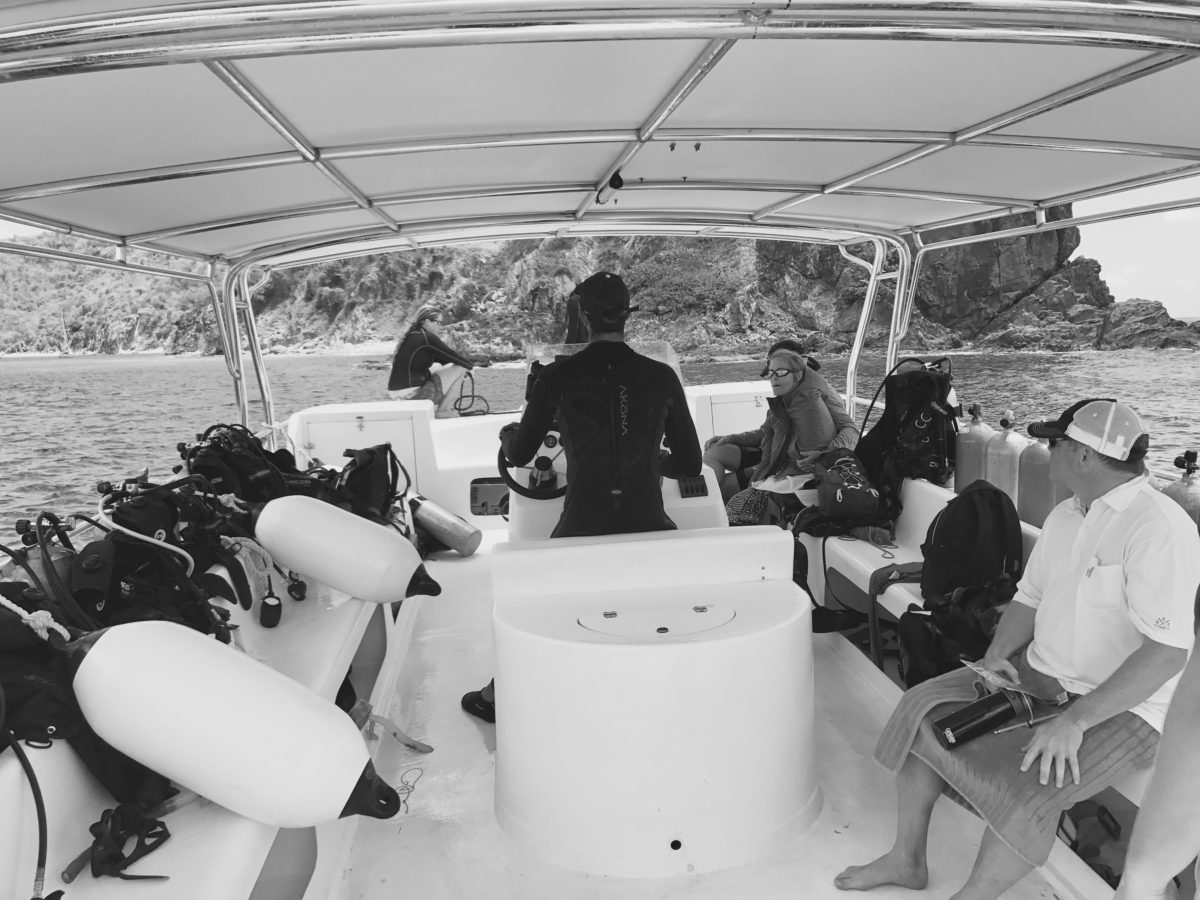Deciding to get your certification can be a little daunting, but the BVI is known to be a great place to dive. I was spending time there visiting my boyfriend, so while he went to work I thought, why not get certified? In short, I spent half my days hanging out underwater, and half of it at a place called Peg Legs where I did my textbook reading while drinking lots of painkillers 🙂
On Tortola, Blue Water Divers in Nanny Cay is the place to go for your certification. For about $500 USD over 4 days you get a textbook and 4 full days of diving to complete the PADI (Professional Association of Diving Instructors) Open Water Dive Certification. I went into this process totally blind, but Blue Water Divers were excellent and now I can go dive anywhere in the world – YAY!
Why diving is great:
- Exposure to wildlife and the underwater world – The best underwater life I ever saw was off Beachcomber Island in Fiji just going along with snorkels, but that’s because I like the soft corals (bright and neon) as opposed to hard coral. If you know what you prefer (large fish vs. intricately patterned fish, glowing coral vs. shipwrecks), you’ll plan wisely and have a better time when you go. I did see a green turtle with a head the size of a small child in the BVI though, and some big sting rays too, so that was neat 🙂
- The people you meet – always a unique and fun bunch. The instructors will play tic-tac-toe on their writing slate with you, you’ll mingle with foreigners, and overall diving is a good time so it’s not uncommon to crack some beers after you’re done for the day and have some laughs together.
- You learn another language – you’ll have to do over 50 types of skills underwater, including a bunch of signs you’ll do in order to communicate with your buddies. Very cool to stretch your brain this way and get uncomfortable.
Tips on diving responsibly:
- Diving can be very damaging to the environment – it’s super important to respect nature, not touching anything (no shells, rocks etc.) that will disturb underwater life. Basically, don’t be a jerk
- Keep your limbs tucked in and don’t kick your fins into coral – that can kill it. BIG no-no. The same goes for making sure all your tubes and gear is packed away as it should be when you set up. Also the more neutrally buoyant you are the better, to help keep you away from marine life.
- Enhancing your knowledge is always an option post Open Water course with the PADI IDC Advanced Diver certification. This is next level for me – but knowledge is power.
Things to consider before you commit to getting your certification:
- Must be ok with rising early – over the four course days I was up ay 6:30am to scram and finish my textbook reading, head for the marina, and complete the pre-dive reading chapter quizzes.
- Conditions will tremendously effect your enjoyment of the experience – my first day it was raining, we were wet, it was cold, and we even got yelled at by some angry guy. I was so cold at one point (even in a spring suit) that my fingertips were white and a little purple. Day 2 and onwards, sun was shining, vibes were up, and we were stoked. Day 1 I wanted to quit, day 2 much better.
- How you keep your cool – getting cut off from your air supply can be pretty scary. If you can’t trust your instructor, gut, and gear you will have a problem. Flooding your mask and ditching it can also be a bit hectic, but your instructor will be by your side until you get it right. Just don’t freak out.
- Reading a lot in a small timeframe – the information is super important in the textbook they give you, so you need to read up fast. Over 250 pages in four days that you will be quizzed on, so no cheats. The final exam is 50 multiple choice questions and 10 written dive table problems focused on depth and time.
In sum:
Having gone down a total of 60 feet in my dives for the week, the nitrogen absolutely kicked my ass. Our final dive in Pellican’s Cove was really nice though; I kept thinking to myself what great color schemes the coral and reef made – there were beautiful deep olive greens, lavenders & dark purples, variations of tan colors & gentle browns. Purple is the strongest hue to maintain underwater, so perhaps thats why it was so pretty. And there were some really nice, soft feather like marine plants that just waved slowly in the water’s movement along with coral plants that looked like big fans you use when its sweltering.
To celebrate, I bought myself a pretty beach cover up (to be fair, I had been wearing my boyfriend’s Dark & Stormy T-shirt he probably got at a bar) and went to Frenchman’s Bay. I accidentally stumbled into a massage place again, Serenity Spa here in the harbor. I needed to kill some time but also felt super worked after the pat 3 days of non-stop diving. So Swedish massage it was!



Found in
adventure travel, caribbean, diving, scuba diving